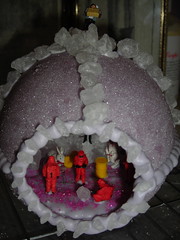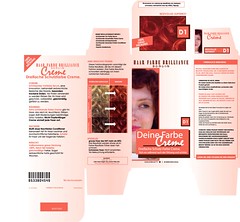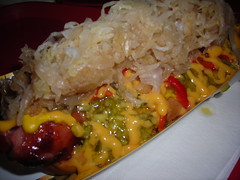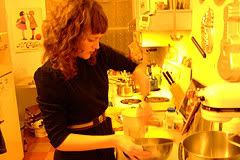I would advise you to chew carefully, to consider utterly the taste and texture of what I am about to offer. You may be about to get an idea of how the king felt when he had that dainty dish set before him of four-and-twenty blackbirds baked in a pie. It certainly wasn't what he was expecting, nor will you be without surprise. For if I have put before you a slice of mock apple pie, you will shortly be tucking into a flaky crust encasing a filling so redolent of apple pie that you may choke when I reveal to you that it is in fact totally devoid of apples, and actually made of Ritz crackers, sugar, lemon and cinnamon.
That the modern world adores fakery is certainly no secret. Fake meat, fake breasts, and fake Louis Vuitton handbags are just a few examples of North America’s romance with artifice. So why don’t we love the mock pie? It mostly resides nowadays in the realm of novelty-lovers and April Fools’ Day tricksters, hardly the position for a pastry with such a rich history. How can you mince around wearing your Calvyn Klyne perfume without a single thought about the perilous downslide into the tomes of History that the mock pie is taking?
Trouble is, even a fake can be faked. A good portion of the recipes using the word “mock” in their title are nothing but reduced-calorie concoctions, which for the most part would fool no one if you tried to fob them off as the real thing. Another misuse of the term is for pastries that don’t actually require rolling a crust, as in a recipe for
Peach Mock Pie that is merely a peach crumble baked in a pie dish, as if baking a proper pie was really such a difficult thing to do. That said, whipping up an apple pie wasn’t always such an easy task.
Consider a life
without apples, for they were not always so readily available. In fact, sweet apples are not native to North America but were brought over by the first English settlers, who packed with them both seeds and cuttings on their voyage across the Atlantic. The fruit subsequently began to flourish in what remain the country’s greatest apple-producing states of the East Coast, but by the mid-nineteenth century had yet to be cultivated in the West, which was still in the throes of its ‘wild’ period. Apples were, for the most part, off-limits to all but the wealthiest. I do not believe it to be mere coincidence that the very same year that mock pie was invented, a shipment of four bushels of Washington apples sold in California for $500, which would have been a fortune at the time. It was thus in 1852 that a group of pioneer women so yearning to provide their children with the apple pie they missed from back east somehow summoned the inventive genius to mix soda crackers with brown sugar, water, citric acid and cinnamon in the hopes of replacing the apples in a pie. In the first known publication of the recipe, it was christened
California Pioneer Apple Pie.
At just about the same time as the invention of the mock apple pie, two gentlemen from Iowa were on their separate ways to make their fortunes growing apples in the Pacific Northwest. Their wagons were loaded with seedlings, and they apparently made the journey subsisting mostly on dried apple pies. These two were not, however, about to make the pioneer women’s invention obsolete. This was still a time before cold storage and radiation. Contrary to what the modern supermarket shopper might believe, apples do have a season. To keep apples the whole year round they needed to be stored in a single layer on a bed of hay with no fruit touching the other. For this reason apples were mostly dried. Crackers remained cheaper and easier to store in barrels. The mock pie endured.
The soda crackers in the pie became Ritz crackers in the early 1930s when a recipe for Mock Apple Pie began to appear on the box. It was the Great Depression, and apples were once again a luxury for those not lucky enough to live on an orchard, which is not to say that people living on orchards were particularly lucky, since fruit crops were not especially profitable at the time, but at the very least they could eat what they grew.
These days it is still slightly cheaper to buy thirty-six Ritz crackers than the eight apples or so required for a nice pie. Cheaper still is McDonald’s apple pie, which currently runs at two for a dollar. At this price you could even get one for each of your dinner guests. I heard a rumour that they use turnips instead of apples, which is most certainly true of most commercial fruitcakes. But after all the processing the filling of such a thing doubtless undergoes, could you really tell the difference?
A number of eminent food writers cite this as the exact problem that the believability of the mock pie denotes. Apples in the supermarket have become so tasteless, so distant from the adored fruit that was brought to North America long ago, that they are nearly indistinguishable from crackers soaked in a sugary, lemony, cinnamon-flavoured syrup. We do not taste the apple in apple pies anymore. The apples available to us commercially are available based on which are the most profitable. Tasteless apples sell better because their taste cannot offend anyone. You can’t sell a blemished one, but you can sell a shiny, uniformly round tasteless one. Most of the varieties that I can find at my local
fruiterie fit this bill. As A.J. Liebling wrote, if pessimistically, “People who don’t like food have made a triumph of the Delicious apple because it doesn’t taste like an apple, and of the Golden Delicious because it doesn’t taste like anything.”
Fortunately, in Quebec at least, one can still find a few tasty varieties of apple, the Cortland being my top pick. Thus, one evening I set myself to the task of baking both an apple pie and a mock apple pie in the hopes of resolving the matter at a semi-official tasting the next day. By semi-official I mean that I had advertised “One day only! Buy one slice of apple pie ($2) and receive a FREE slice of mock apple pie! (Under the condition that you fill out a short survey)” at my sort of sketchy Backroom Bakeshoppe. I do regret that the morning of the Official Taste Test I did not come up with particularly in-depth questions for my survey. This may have had something to do with the fact that I was up until two o’clock in the morning making two kinds of pie (and testing a revolutionary new dough recipe). The survey answers, in kind, were not particularly in-depth.
I did, however, manage to lure about nine people to my taste test, and each one dutifully filled out the four questions on their survey card. When asked whether the mock pie resembled apple pie, they generally agreed that it resembled a storebought pie “to a shocking degree.” They may have been more willing to say it resembled any apple pie, storebought or otherwise, if I hadn’t provided such a stellar example of good homemade apple pie alongside. When faced with the second question of whether the mock was good, one respondent noted that “it seemed good before I ate the real one,” while someone else chose to skirt the question by replying only, “It is a remarkable experiment in the psychomatology of taste.” Next, I asked whether it was more likely to find apples or Ritz crackers in one’s home. The most popular response was neither, but at least one person admitted to having at least seen apples in their apartment. One sly duck replied, “What’s apples? Ritz.” The last section was reserved for any other comments, but respondents tended to embellish their answers to the first question, referring to mock pie as “black magic alchemy” and asserting, “It’s scary that Ritz crackers can taste like that.”
A success? I think so, though the two professional cooks at the tasting complained that the mock pie lacked acidity and texture. Subsequently, however, I brought a slice of the mock pie to one of Montreal’s most distinguished restaurants, where the cooks were quite dumbfounded.I first presented it to the pastry chef, who called the chef, who was inevitably followed by the entirety of the kitchen staff, and finally a few straggling waiters. The small pastry kitchen was crammed to the gills, and everyone there was fooled. An intern even requested the recipe so she could make it for her fellow students at the pastry school.
That it is a good bet for stymieing professional cooks or any average Joe is just one reason to continue making mock apple pie in this age of the ubiquitous apple. There are ample others. Or perhaps you have an overwhelming craving for apple pie but are trapped in the apartment due to, say, a raging blizzard, or secret police keeping guard at your door, and you don’t have any apples but do have a lifetime supply of Ritz crackers. Or maybe you’re very unfortunately allergic to apples, which sounds like a dubious sort of allergy to me, but apparently 40 to 90% of birch pollen allergic people in Northern Europe and North America are sensitized to apples. (And as a person allergic to broccoli, I’m not really one to talk.) However, I think the best reason to make mock pie is just a plain and simple hatred of
Malus domestica. To quote the introduction to one mock apple pie recipe I unearthed, “Love apple pie, but hate apples? Your prayers have been answered!” I believe this is somewhat akin to “Love the sinner, hate the sin.”
But the Ritz apple pie is not the only mock pie. After all, what if you love apple pie, but hate both apples
and crackers? Fret not. I have found another recipe for mock apple pie that replaces apples with zucchini. In mock cherry pie, cranberries and raisins take the place of the classic stone fruit. A number of recipes for mock pecan pie exist, likely born of the logic that pecan pie is extremely delicious, but pecans are also prohibitively expensive and rather high in fat if you happen to be worried about that sort of thing. Most recipes are much like the original, containing a base of eggs, vanilla, brown sugar and dark corn syrup, but substituting the nuts with cornflakes, waterlogged Grapenuts, or a mixture of dry oatmeal and coconut. The most interesting mock pecan pie recipe, however, is made by mashing cooked pinto beans with sugar, spices, and eggs. I sincerely regret not having had the time to make that one.
The greatest atrocity I encountered was the mock coconut cream pie that consisted of powdered milk, low-cal sweetener, and cooked spaghetti squash, unaccountably seasoned with nutmeg. Should one really be so enamoured of coconut cream pie, I would suggest either saving up dollars or calories until one can afford to indulge in the real thing, lest this foul concoction forever put a person off food in general. This is simply not a valid use of spaghetti squash.
With the exception of that obvious error, though, what really
belongs in a pie? Who decides? After all, many of the things we’re used to finding in our beloved traditional pies are actually kind of odd. Rhubarb, for instance, is a very sour vegetable, nothing like a peach. A pumpkin is just a great big squash.
The Martha Stewart Cookbook includes recipes for such unexpected pastries as
Beet Pie, Carrot-Parsnip Pie, Green Tomato Pie, and
Sweet Spinach Pie. None of those sound particularly appealing to me, mired in preconceived pastry notions as I am, but, then, a pie full of soggy crackers didn’t sound very appetizing either, and it turned out to be so palatable that a group of revelers polished it off during the night when I left it on the counter in the bakery. This explains why I didn’t get more survey respondents—no one would own up to having taken part in the illicit intoxicated feast.



